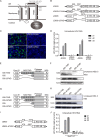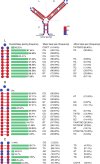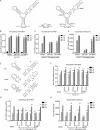Genetic Analysis of Serum-Derived Defective Hepatitis C Virus Genomes Revealed Novel Viral cis Elements for Virus Replication and Assembly
- PMID: 29367245
- PMCID: PMC5972877
- DOI: 10.1128/JVI.02182-17
Genetic Analysis of Serum-Derived Defective Hepatitis C Virus Genomes Revealed Novel Viral cis Elements for Virus Replication and Assembly
Abstract
Defective viral genomes (DVGs) of hepatitis C virus (HCV) exist, but their biological significances have not been thoroughly investigated. Here, we analyzed HCV DVGs circulating in patient sera that possess deletions in the structural protein-encoding region. About 30% of 41 HCV clinical isolates possess DVGs that originated from the full-length genome in the same patients. No correlation between DVGs, viremia, and alanine aminotransferase (ALT) levels was found. Sequencing analysis of DVGs revealed the existence of deletion hot spots, with upstream sites in E1 and downstream sites in E2 and NS2. Interestingly, the coding sequences for the core protein and the C-terminal protease domain of NS2 were always intact in DVGs despite the fact that both proteins are dispensable for HCV genome replication. Mechanistic studies showed that transmembrane segment 3 (TMS3) of NS2, located immediately upstream of its protease domain, was required for the cleavage of NS2-NS3 and the replication of DVGs. Moreover, we identified a highly conserved secondary structure (SL750) within the core domain 2-coding region that is critical for HCV genome packaging. In summary, our analysis of serum-derived HCV DVGs revealed novel viral cis elements that play important roles in virus replication and assembly.IMPORTANCE HCV DVGs have been identified in vivo and in vitro, but their biogenesis and physiological significances remain elusive. In addition, a conventional packaging signal has not yet been identified on the HCV RNA genome, and mechanisms underlying the specificity in the encapsidation of the HCV genome into infectious particles remain to be uncovered. Here, we identified new viral cis elements critical for the HCV life cycle by determining genetic constraints that define the boundary of serum-derived HCV DVGs. We found that transmembrane segment 3 of NS2, located immediately upstream of its protease domain, was required for the cleavage of NS2-NS3 and the replication of DVGs. We identified a highly conserved secondary structure (SL750) within the core-coding region that is critical for HCV genome packaging. In summary, our analysis of serum-derived HCV DVGs revealed previously unexpected novel cis elements critical for HCV replication and morphogenesis.
Keywords: NS2; cis elements; core; defective genome; hepatitis C virus; virus packaging.
Copyright © 2018 American Society for Microbiology.
Figures








Similar articles
-
Characterization of the Determinants of NS2-3-Independent Virion Morphogenesis of Pestiviruses.J Virol. 2015 Nov;89(22):11668-80. doi: 10.1128/JVI.01646-15. Epub 2015 Sep 9. J Virol. 2015. PMID: 26355097 Free PMC article.
-
Palmitoylation of Hepatitis C Virus NS2 Regulates Its Subcellular Localization and NS2-NS3 Autocleavage.J Virol. 2019 Dec 12;94(1):e00906-19. doi: 10.1128/JVI.00906-19. Print 2019 Dec 12. J Virol. 2019. PMID: 31597774 Free PMC article.
-
Involvement of ribosomal protein L17 and Y-box binding protein 1 in the assembly of hepatitis C virus potentially via their interaction with the 3' untranslated region of the viral genome.J Virol. 2024 Jul 23;98(7):e0052224. doi: 10.1128/jvi.00522-24. Epub 2024 Jun 20. J Virol. 2024. PMID: 38899899 Free PMC article.
-
cis-Acting RNA elements in the hepatitis C virus RNA genome.Virus Res. 2015 Aug 3;206:90-8. doi: 10.1016/j.virusres.2014.12.029. Epub 2015 Jan 7. Virus Res. 2015. PMID: 25576644 Free PMC article. Review.
-
The hepatitis C virus NS2/3 protease.Curr Issues Mol Biol. 2007 Jan;9(1):63-9. Curr Issues Mol Biol. 2007. PMID: 17263146 Review.
Cited by
-
Broad and Dynamic Diversification of Infectious Hepatitis C Virus in a Cell Culture Environment.J Virol. 2020 Feb 28;94(6):e01856-19. doi: 10.1128/JVI.01856-19. Print 2020 Feb 28. J Virol. 2020. PMID: 31852791 Free PMC article.
-
RNA Structures and Their Role in Selective Genome Packaging.Viruses. 2021 Sep 8;13(9):1788. doi: 10.3390/v13091788. Viruses. 2021. PMID: 34578369 Free PMC article. Review.
-
Generation of Defective Interfering Particles of Morbilliviruses Using Reverse Genetics.Methods Mol Biol. 2024;2808:57-70. doi: 10.1007/978-1-0716-3870-5_5. Methods Mol Biol. 2024. PMID: 38743362
-
Development of a Singleplex Real-Time Reverse Transcriptase PCR Assay for Pan-Dengue Virus Detection and Quantification.Viruses. 2022 Jun 10;14(6):1271. doi: 10.3390/v14061271. Viruses. 2022. PMID: 35746742 Free PMC article.
-
Structure and function analysis of the essential 3'X domain of hepatitis C virus.RNA. 2020 Feb;26(2):186-198. doi: 10.1261/rna.073189.119. Epub 2019 Nov 6. RNA. 2020. PMID: 31694875 Free PMC article.
References
-
- Li D, Huang Z, Zhong J. 2015. Hepatitis C virus vaccine development: old challenges and new opportunities. Nat Sci Rev 2:285–295. doi:10.1093/nsr/nwv040. - DOI
Publication types
MeSH terms
Substances
LinkOut - more resources
Full Text Sources
Other Literature Sources

